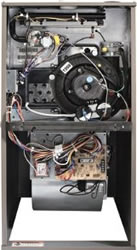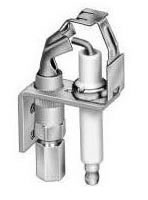We often take our gas furnace for granted, yet the gas furnace has evolved dramatically over the last few decades. The reason for the changes is primarily driven by the cost and availability of natural gas.

Figure 1 - High efficiency gas furnace
In a similar manner to the big block car engines of the 60’s through the 80’s, early gas furnaces were not efficient. In fact, on average, with older gas furnaces more than half of the energy goes up the flue pipe.
In the US new gas furnaces by government regulation must have an efficiency or AFUE rating of at least 78%.
To achieve a gas furnace efficiency of 78% required that technology come to the rescue as it was impossible to take the conventional gas furnace and make it that much more efficient than it was.
Always remember that the AFUE rating on your gas furnace was created in a laboratory environment with a new, perfectly set-up and operating gas furnace. It is highly unlikely that you will achieve the AFUE rating efficiencies in your home.
In order to better understand the differences in gas furnaces we will look at each basic type of gas furnace. There are 3 types of gas furnaces and although each manufacturer has honed his model to be the best in its class
, the technologies are basically the same.
- Conventional warm air gas furnace – an AFUE rating of 55% to 65%
- Induced draft warm air gas furnace – an AFUE rating of 80% to 82%
- Condensing warm air gas furnace – an AFUE rating of 90% to 95%
Note: The names of the different types of gas furnaces are based on their principal technology used to achieve the energy efficiencies.
Note: Most warm air gas furnaces can be purchased to operate from natural gas or propane.
- Conventional warm air gas furnaces
- Induced draft warm air gas furnaces
- Intermittent pilot, as shown in Figure 2. The intermittent pilot is a two stage process. It uses a spark, similar to a spark plug in your car engine to ignite the pilot light which in turn ignites the gas being delivered to the burners.
- Hot surface ignition, as shown in Figure 3. The hot surface ignition technology is a simple one stage process. It uses an element, similar to a toaster, to ignite the gas being delivered to the burners.
A conventional warm air gas furnace has a continuously operating pilot light known in the trade as a standing pilot. The furnace will have a flue that rises from the furnace and exits through the roof of the home. When the furnace calls for heat, the pilot light ignites the gas being delivered to the burners in the furnace.
With a conventional warm air furnace even if you are operating the air conditioning system you are consuming gas for the pilot light.
A conventional warm air gas furnace creates a natural draft by drawing air in from an opening in the front of the furnace and allowing the hot combustion gases to escape up the flue.
Conventional warm air furnaces have an AFUE rating of between 55% and 65%.
The induced draft warm air gas furnaces use an electronic ignition system. There is no standing pilot and the furnace only consumes gas when the furnace is called on to delivery heat to the home.
There are two types of electronic ignition systems used in induced draft warm air gas furnaces:

Figure 2 - Intermittent pilot igniter

Figure 3 - Hot surface igniter
- Condensing warm air gas furnaces
The induced draft warm air gas furnace incorporates a fan to draw the combustion gases into the flue (induced draft) which increases the efficiency of the furnace.
Induced draft warm air gas furnaces have an AFUE rating of between 80% and 82% because of the electronic pilot light technologies and the incorporation of the induced draft.
The condensing warm air gas furnace, as shown in Figure 1, is often designated the high efficiency condensing furnace
. Its increase in efficiency over the induced draft warm air gas furnace is due to the addition of a second heat exchanger. The flue gases are passed through an independent heat exchanger which removes the heat from the flue gases and uses it to heat the home.
The condensing warm air gas furnace uses a hot surface electronic ignition system, as shown in Figure 3.
Besides the increased efficiency the condensing warm air gas furnace does not need a conventional through the roof flue. As the flue gases are cool, after being passed through the heat exchanger, they can be exhausted through a PVC pipe horizontally through a wall. The cooling of the flue gases does produce water and that is directed to a floor drain.
The condensed warm air gas furnace have an AFUE rating of between 90% and 95% due primarily to the second heat exchanger, but also the electronic hot surface ignition system.
